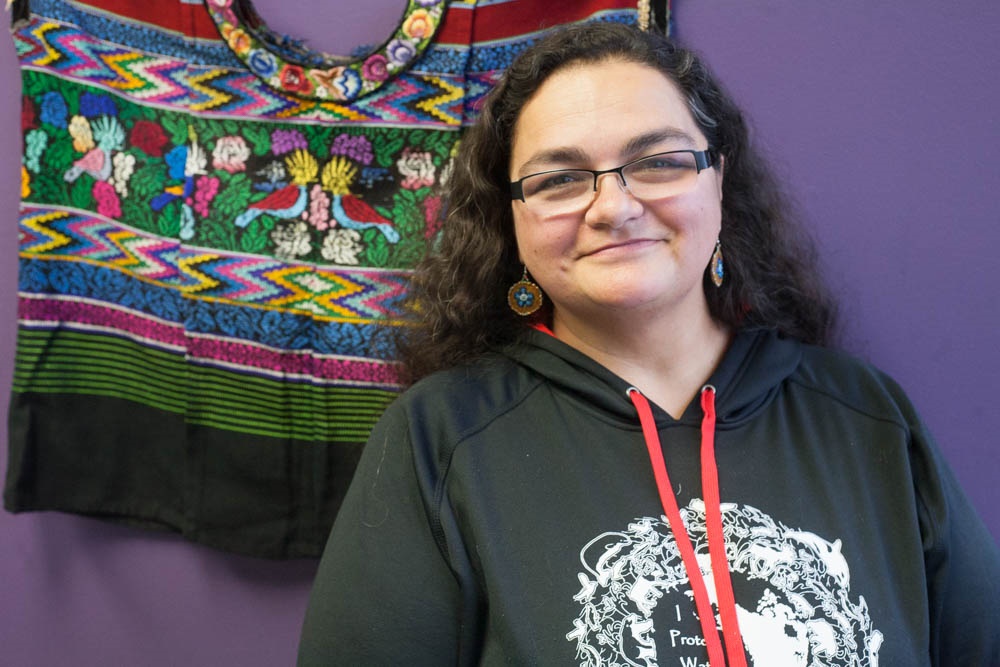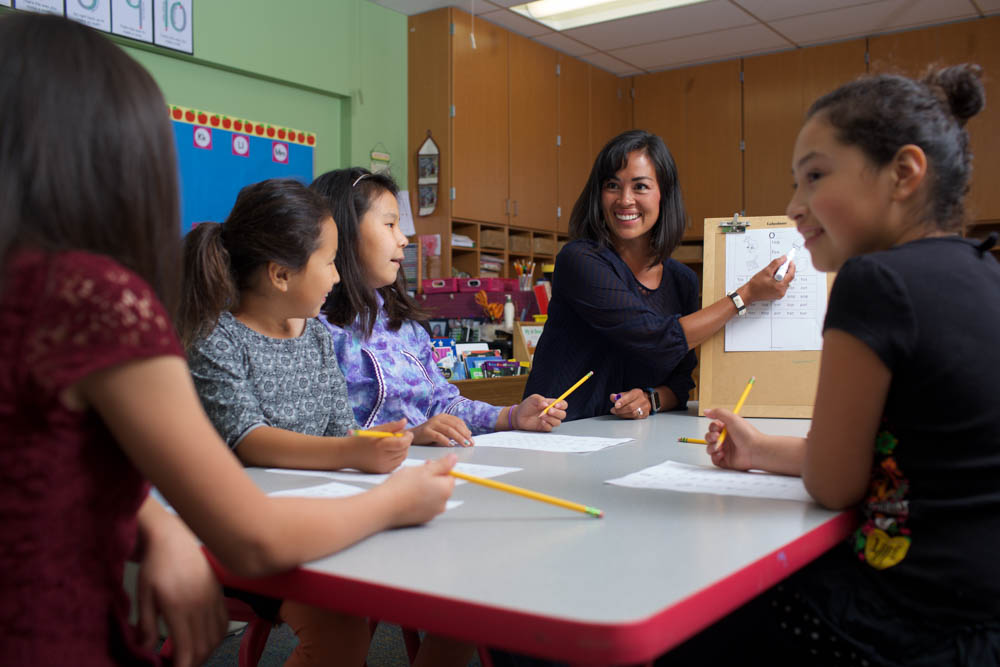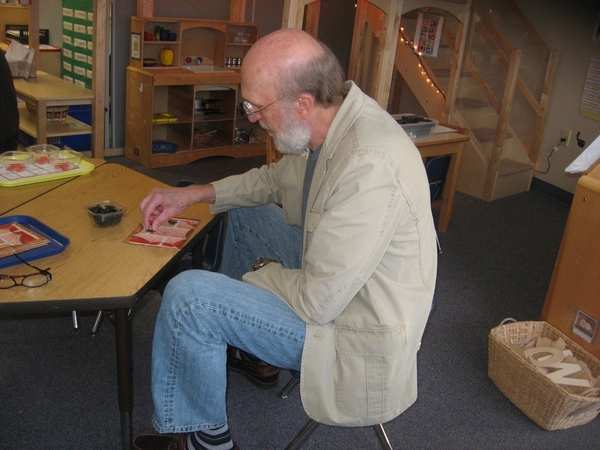It was the little red trauma-informed schoolhouse.
Katherine Wickersham-Wade, the Nay’dini’aa Na’ Kayax (Chickaloon Village) clan grandmother who started the Ya Ne Dah Ah School, Alaska’s first Tribally operated school in 1992, might not have used that language. But she did envision a school that would wrap its students in Native ancestral traditions and Ahtna language, instill self-confidence and repair some of the damage inflicted by historical trauma—the disruptions to culture and community caused in part by railroad and road-building, coal mining and colonialism.
In 2005, the school graduated from its small, red-clad structure to a more modern 2,400 square foot building. Though still compact—it serves eighteen students, from toddlers to teenagers—it has become a powerful model of trauma-informed practice. (See Resources for more.)
Students work at communal tables; an “honor wall” includes photographs and artifacts of previous generations and loved ones who have passed. Community elders and parents supplement the work of one full-time and two assistant teachers, and the curriculum is flexible; if a visitor stops by with a live porcupine or a moose hide, staff will seize the opportunity for an impromptu science lesson.

“When I first took over the school, there was a focus on the children’s deficits,” says Lisa Wade, granddaughter of Ya Ne Dah Ah’s founder and Health, Education and Social Services Director for the Traditional Council/Tribal Government. “We learned that we needed to focus on their strengths.”
The school also needed a multi-generational approach. “A lot of students who struggle in school can be a result of having parents who are struggling at home for a variety of reasons,” Wade says. “By supporting parents, we are able to ensure better attendance and school performance, as well as happier and healthier children.” The school supports staff as well, with massage and wellness services and psychological counseling when needed.
What’s more, the lessons of Ya Ne Dah Ah are beginning to percolate across the Mat-Su Borough, an area roughly the size of Virginia. “They’re committed to becoming a trauma-informed school district by 2020,” Wade says. “I’m pleased that we’re being invited into the conversation. We are even offering to help provide education to Mat-Su Borough schools around historical and intergenerational trauma and the importance of developing and fostering cultural humility.”
In a Mobilizing Action for Resilient Communities (MARC) learning collaborative webinar facilitated by network leaders from Alaska and Washington, the subject was schools: How networks can support and promote trauma-informed, resilience-based change from early childhood to graduate-level programs.

In Alaska, home to remote rural schools, public boarding schools attended primarily by Alaska Native peoples and the urban polyglot schools of Anchorage, where 99 different languages are spoken, network leaders work to ensure that trauma-informed change is also equity-based, with attention to economic and racial disparities.
“We’re working…to revise how we teach about trauma, so we can help school systems to have that lens, not only about the ten [original] ACEs but also the dynamics of racism and other stressors,” says Laura Norton-Cruz, Director of the Alaska Resilience Initiative.
In Walla Walla, where Lincoln High School gained national visibility for its trauma-informed turnaround, captured in the film Paper Tigers, Community Resilience Initiative (CRI) co-founder Teri Barila likes to point out that “there are many paper tigers in Walla Walla beyond our educators, all working toward ‘How can we embed this learning into our daily practice?’”
CRI helped to answer that question by “moving upstream”—in this case, by training Head Start staff on ACEs and resilience. The response was so powerful that child-care providers wanted to be trained, as well, prompting CRI to deliver six modules over a six month period.
“It’s the idea that change starts with adults; if we don’t have our own self-understanding and self-regulation, we can’t maximize that for the children,” Barila says. In an effort to demonstrate when the “mental model shift” is in place, CRI invited managers and policy-makers—including the sheriff, police chief, a city council member, county commissioner and others—to tour a Head Start program, perch in the toddler-sized chairs and witness resilience-building practices from the ground up (pictured above).
Three hundred and fifty miles away in Whatcom County, network leaders held a training for facilitators that included educators from early childhood to the university level. Geof Morgan, former executive director of the Whatcom Family and Community Network (WFCN), notes that more schools and youth serving organizations that partner with schools are incorporating the science of ACEs and resilience into professional development; more are implementing restorative practices, using conflict-resolution and community-building circles and eliminating policies that require families to pay for students’ participation in teams or clubs.
“In higher education, we’re seeing a move toward inclusion of [trauma and resilience] content into a variety of disciplines,” says Kristi Slette, who now heads WFCN. The network has supported a five-year “culture shift” at one local middle school, which recently had a chance to put restorative practices to work.
When some students at Shuksan Middle School walked out in protest of the presidential election outcome and headed for a mall on Inauguration Day 2017, they were given the option of attending a Saturday session in lieu of suspension. There, they watched a documentary on the Birmingham Children’s Crusade of 1963 and discussed civil disobedience, political action and consequences. “These students were not marginalized or shut down; instead, they were brought closer,” Slette says. “Time together allowed school staff to better understand the student’s perspectives and for the students to gain insight on their intent, actions and future civic impact. Accountability was established in a rich, respectful and restorative way that provided opportunity and built skills—not just punished and isolated.” (See Resources for more.)
In the small, rural school district of Washington’s Nooksack Valley, administrators recognized that their schools were part of a larger system. “They said, ‘We’ve been doing our best; we can’t do this alone. Can you help us?’” Morgan says. The network helped school leaders invite community members into conversations about resilience. Together, they developed a framework for a resilient community that put “strong and healthy relationships” at the center. (See Resources for more.)
Morgan would like to use data to further such resilience-building efforts. “We’re hoping we can get some asset-based and hope-based questions added to the BRFSS so people can tell a data story that’s about resilience as well as risk.”
Meantime, at Ya Ne Dah Ah, instructors teach lessons in the Ahtna Athabascan language to underscore values, with words that mean “honor ancestors” or “respect for each other at all times.” Students learn drumming and ancestral melodies.
“Every word that is spoken, every song that is sung, is healing for our people,” says Wade. “When the elders hear those songs, they cry because they are happy. That’s validation for our students.”
- See excerpts from the MARC learning collaborative webinar facilitated by network leaders from Alaska and Washington:
- WATCH: Lisa Wade shares the approach used at Ya Ne Dah Ah Tribal School to address trauma.
- WATCH: Kristi Slette shares an example of how a trauma-informed approach is applied at Shuksan Middle School when students walk out on Inauguration Day 2017.
- WATCH: Geof Morgan shares a brief origin story of the community resilience initiative launched by the Nooksack Valley School District.
- Check out the Alaska Resilience Initiative’s website, which features tools for trauma-informed change, including:
- Alaska Department of Education & Early Development’s eLearning module for school staff, Overcoming ACEs in Alaskan Schools
- Anchorage School District's training webinar, Trauma & Culturally Responsive Practices
- Check out the Community Resilience Initiative resources, including research papers such as Trauma Informed Practices Implemented by Eleven Local Organizations, Members of the Children’s Resilience Initiative, in Walla Walla, Washington State (Longhi & Brown, 2016).
- Visit What Works for Health from the County Health Rankings and Roadmaps to get an overview of the evidence for trauma informed schools.
- Join the ACEs in Education community on ACEs Connection—a group to share ideas on mitigating the effects of adverse childhood experiences in the K-12 environment.
- Watch Dr. Christopher Blodgett’s Brown Bag Webinar: The Status of Trauma-Informed School Practice: https://youtu.be/IZx4MWF1B7o
This article was originally posted April 23, 2018, on MARC.HealthFederation.org and was written by @Anndee Hochman, a journalist and author whose work appears regularly in The Philadelphia Inquirer, on the website for public radio station WHYY and in other print and online venues. She teaches poetry and creative non-fiction in schools, senior centers, detention facilities and at writers' conferences.
To read more from the MARC Shared Learnings series, visit: http://marc.healthfederation.org/shared-learnings
Title Image: City Council Member Steve Moss visits a Head Start program in Walla Walla, WA.



Comments (0)